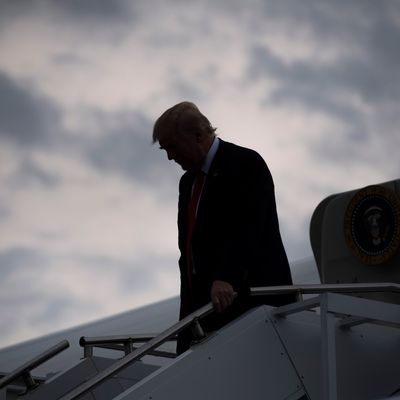
The explosive allegation that the White House and Fox News coordinated a conspiracy theory about the murder of Seth Rich presents two disturbing yet widely accepted realities about the workings of the modern Republican Party. The first is the hand-in-glove relationship between a putative news organization and elected officials. The revelation that George F. Will, a columnist and not even a reporter, helped prepare Ronald Reagan for a debate in 1980 was once considered a major scandal. Today such news would barely register.
More disturbing is the apparent seamless integration of the White House with the fever swamp. This represents a historical milestone of sorts. Trump’s administration has fully erased the boundary between legitimate conservatism and the most disreputable paranoid discourse on the far right.
The allegations, contained in a lawsuit, have not been proven. But the most important fact they allege, that Fox News commentator Ed Butowsky claimed Trump himself reviewed the story in the White House and was eager to see it published, is substantiated by a screenshot of a text from Butowsky. (Butowsky now claims this statement was a joke, which is also the defense the White House offers of Trump’s urging of police to rough up suspects, Trump ordering Comey to back off investigating Michael Flynn, Trump urging Russia to hack his opponent’s emails, as well as the explanation Kevin McCarthy has put forward for his recorded suspicion that Trump was paid by Russia. It is a true age of dry wit in the Republican Party.)
Trump of course built his political brand by stoking a conspiracy theory about Barack Obama’s birthplace. Trump’s birtherism gave him the authentic connection to the conservative base that made his many past ideological heresies forgivable. He has continued to spread wild and baseless rumors: Antonin Scalia may have been murdered, Ted Cruz’s father may have helped assassinate President Kennedy, millions of illegal votes allowed Hillary Clinton to win the popular vote, Russia did not try to help him win the election.
These bizarre lies are not merely a symptom of Trump’s idiosyncratic verbal diarrhea. They grow out of a long tradition of paranoia that once lurked on the margins of American politics. Paranoid thinking can be found on both the far right and the far left. But while left-wing paranoia remains mostly confined to the margins — Jill Stein’s candidacy acted as a magnet for the left-wing sort — the right-wing variety has made deep inroads into Republican politics.
One of the cherished myths of conservative history holds that William F. Buckley cast the John Birch Society out of the movement for its lunatic thinking. The true story, detailed by Alvin Felzenberg in National Review, is much less stark. The Birchers were indeed stark raving mad, and their beliefs included the conviction that water fluoridation was a Communist plot to weaken the populace, and Dwight Eisenhower was a Communist agent. But the Birchers were far too numerous and influential to alienate completely.
Buckley tried to walk a careful line. He called for Robert Welch to resign from the John Birch Society, but did not denounce the group itself. And even in his dealings with Welch he tried to maintain decent relations. “You will no doubt be hearing from around the country that I have been criticizing you and the John Birch Society. I want you to know that that is incorrect: I have been criticizing you, but not the Society …” he wrote Welch. “We shall continue, then, to do much disagreeing about this and no doubt in vigorous language; but I hope we can maintain a pleasant personal relationship. I am prepared to, if you are.”
Conservatism is not at its core a conspiracy theory, but paranoid thinking has always had an outsize role within the conservative movement. Core movement texts, like Phyllis Schlafly’s Conscience of a Conservative A Choice, Not an Echo and John Stormer’s None Dare Call It Treason, told lurid, unhinged narratives of hidden elite treachery. The movement’s decades-long march throughout the Republican Party allowed it to create alternative movement-controlled think tanks and news organizations that cultivated their own internal reality, a closed epistemology in which facts attributed to non-conservative sources could be ignored or dismissed out of hand.
As the party has moved farther and farther right, it has grown increasingly skeptical of facts and knowledge emanating from Establishment sources (the mainstream media, academia, the Congressional Budget Office, and so on) and increasingly open to kooks. The boundaries have extended farther and farther over the the decades, and under Trump they have taken a noticeable leap. Trump brought into his administration Michael Flynn, an enthusiastic purveyor of exotic theories — Al Qaeda has built a secret trail with signs leading its followers to infiltrate the southern border, Hillary Clinton is implicated in sex trafficking, and so on. Trump openly courts crackpots like Alex Jones. Conspiracymongers like Mike Cernovich and Roger Stone have regularly broken scoops from the Trump administration, indicating a closeness to power that they never enjoyed before.
The lawsuit claims that President Trump personally directed Fox News to report false “facts” in its Seth Rich story. The allegations may or may not be borne out. What is telling is that the image the suit summons, of the president of the United States using his office to advance a feverish conspiracy theory, is not remotely unimaginable.






























